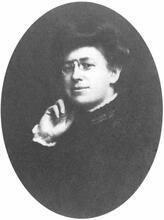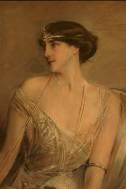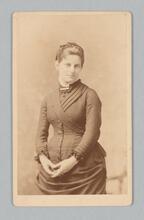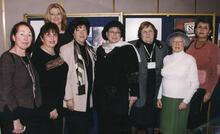Irene Rothschild Guggenheim
In 1894, Ida Clemens, a social worker, asked Irene Rothschild Guggenheim (wife of mining magnate Solomon Guggenheim) to help establish a day nursery for children of working women. This project became Brightside Day Nursery, a facility that offered care for children as young as ten days old through kindergarten age; for 54 years, Guggenheim served as president. By 1904 Brightside offered day care; after-school programs; classes in sewing, gardening, and other skills; and Saturday religious school. It also created a library, a savings fund, a “mothers’ club,” and a summer home for children. In the late 1920s, Guggenheim created the Cannon Street Health Center, which offered nutrition classes and medical and dental services for mothers and children. Later in life, she became the director of the Association of Day Nurseries of New York City and a trustee of the Federation of Jewish Philanthropies.
Early Life and Family
Irene Rothschild Guggenheim, child welfare advocate and art collector, was born in New York City on December 16, 1868, daughter of Victor Henry and Josephine (Wolf) Rothschild. Her father had come to the United States from the German state of Würtemberg in 1852. During the Civil War, he settled in New York City and opened a manufactory for men’s shirts that later expanded into a thriving men’s and women’s ready-made clothing business. The Rothschilds had five children, three daughters and two sons; Irene was the second daughter.
Brightside Day Nursery
Irene attended public school and Normal College (later Hunter College). She also studied in Germany at Miss Lindner’s School in Frankfurt-am-Main between 1882 and 1884, and at a private school run by Madame da Silva in New York City. In the early 1890s, she began to perform charitable work with poor and afflicted children in New York City. In 1894, Ida Clemons, a social worker, asked Irene to help establish a day nursery for the children of working women. This institution, the Brightside Day Nursery, and its offshoot, the Cannon Street Health Center, became Guggenheim’s life work. Elected its first president, she held that office for fifty-four years. Her marriage in 1895 to Solomon Guggenheim, mining magnate, and the birth of three daughters—Eleanor (1896), Gertrude (1898), and Barbara (1904)—did not diminish her involvement.
The Brightside Day Nursery was located on the Lower East Side, where the preponderance of working-class Jewish immigrants lived. The nursery consisted of a crèche for infants as young as ten days old, and a kindergarten for children up to six years old that, within a year of its inception, was serving more than fifty children a day. The program was designed with the help of Lillian Wald and Mary Brewster, who had established a public health nursing service in the same neighborhood the previous year. It reflected the growing interest in early childhood programs spurred by the model day nursery at the Chicago World’s Fair in 1893, and the establishment of kindergartens in other immigrant neighborhoods. Open from seven a.m. to seven p.m. six days a week, the program made it possible for single Jewish mothers to earn a living while their children were bathed, fed, clothed, and instructed by competent caretakers.
Brightside as Social Reform
Like other such institutions, the Brightside Day Nursery was a means of social reform as well as a charitable organization, and as the managers began to perceive the need for other social services they added programs. By 1904, the institution not only provided a day nursery for 150 children, but also served as an after-school facility for graduates. In addition, one hundred girls per day attended industrial classes in sewing, millinery, embroidering, raffia work, and kitchen gardening, while 250 boys and girls came to Saturday morning religious school. The board established a savings fund and circulating library for neighborhood children, sponsored seventeen clubs for older children and a monthly “mothers’ club,” and opened a summer home where children could stay in the country for two weeks or longer.
While mothers who could afford to pay contributed five cents a day toward each child’s support, the institution was primarily funded by charitable contributions. To this end, the almost unlimited resources of the Guggenheim family were particularly helpful. Various members of the Guggenheim and Rothschild families also served as directors of the organization, which continued to grow and diversify. In the late 1920s, the Brightside Day Nursery spawned the Cannon Street Health Center, which provided a range of services including nutrition classes, medical and dental services for children and their mothers, and intelligence testing. The Brightside Day Nursery continued its work until 1948.
Other Involvements
Guggenheim became a director of the Association of Day Nurseries of New York City, which set standards for and attempted to improve and coordinate the work of many of the city’s child care institutions. In addition, she served as a trustee of the Federation of Jewish Philanthropies and was active in other New York City organizations. Like other members of the Guggenheim family, she and her husband belonged to Congregation Emanu-El in New York City.
Guggenheim was also interested in art. After her marriage, she and her husband collected old masters that ranged from Italian Renaissance panels to nineteenth-century Barbizon oils. She was particularly fond of the works of Antoine Watteau, an early eighteenth-century French rococo painter. When Solomon became interested in nonobjective contemporary paintings in the late 1920s, Guggenheim remained involved in his collecting and his foundation, and even proposed Frank Lloyd Wright as the architect for what later became the Solomon R. Guggenheim Museum.
Irene Rothschild Guggenheim died on November 25, 1954, five years after the death of her husband. She gave meaning to her life of comfort and privilege through her philanthropic efforts to assist poor Jewish women and their children.
Brightside Day Nursery. Annual reports.
Davis, John H. The Guggenheims: An American Epic (1978).
Guggenheim Family Papers. Archives of the Guggenheim Brothers and the Solomon R. Guggenheim Foundation, NYC.
National Cyclopedia of American Biography 44:174.
New York Charities Directory.
Obituary. NYTimes, November 29, 1954, 25:1.
WWIAJ (1938).







